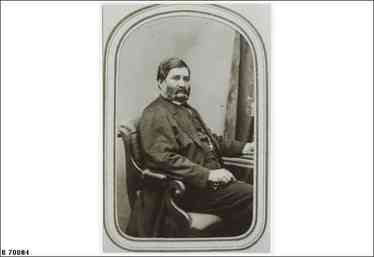 Arthur Horrocks - courtesy State Library South Australia
Arthur Horrocks - courtesy State Library South Australia Fanny Port had been in the service of Arthur Horrocks, a farmer in Penwortham, Clare Valley, for around 4 months as cook and general servant. Arthur Horrocks was the brother of the famous explorer and pastoralist, John Ainsworth Horrocks.
One morning, he found her crying and upon asking what was wrong, she stated that people were endeavouring to injure her good name by spreading rumours that she was pregnant. Horricks tried to reassure her that if this was the case then she should be afforded help and all the attention she needed. She thanked Horrocks for his kind offer, but refused to admit to the pregnancy.
A little later, and still suspicious, Horrocks searched her room and found evidence to suggest that the rumours were true. Fanny finally admitted to having already giving birth, and told him the baby had died and was buried only 50 yards from the house. Worried that she had hurt the child, he asked her the question, to which she replied “Oh no, Sir, I would have kept it had it breathed” she also added “it was a very pretty little girl”.
Fanny took him to the spot where she had buried her baby and he marked the spot before sending word to the local Magistrate. The police arrived and soon after exhumed the body, being careful not to damage it in any way. The dead body of the child was quickly taken to Clare for examination.
Despite Fanny’s insistence that the child had not breathed when born, the examination by Dr Foster Steadman, showed otherwise. They tested the lungs and they floated… a sure sign, he said, that the baby had been breathing before she died. The valve in the heart was closed also, another sign that the baby had been alive when born, and that there had been circulation.
The head was exhibiting discolouration from extensive bruising and the scalp was swollen. After removing the scalp, the examiner found blood on the skull from internal bleeding which, he believed would have been the cause of death. He did not consider that such damage would be done through childbirth, but would have to be delivered by blows from a blunt source, possibly knuckles. He could not find anything else to account for the child’s death.
Mr Parker, for the defence, argued that no child's cry had been heard and that Mr Horricks had witnessed only weeks earlier, Fanny preparing clothing for her child. He pointed out that she had always been of a kindly disposition towards other people’s children and that it would be out of character for her to ever harm a child, never mind her own. He reminded the jury of Fanny’s comment, said with fondness “it was a pretty little girl”. He put to the jury, if there was any doubt at all in their minds, they must not find her guilty of murder but that the crime of concealment would be more fitting.
With that, the Jury retired and returned with the verdict of Not Guilty of murder, but guilty of concealment, which was in those days, a crime in itself.
Mr Justice Cooper proceeded to pass sentence in a low and solemn tone.
“Fanny Port, you have been vindicated for the wilfull murder of your own child; the jury have acquitted you of that dreadful crime, but found you guilty of the lesser offence of concealment” he continued by reminding her that “Had the Jury been compelled to have found you guilty of infanticide, it would have been incumbent on me to pronounce the sentence of death upon you, and having done so I would have no power to avert it. You would have been taken from where you now stand, and, in a few days, at the place of public execution, your life would have paid the penalty of the dreadful offence charged to you.”
He reminded her that a kind offer of help had been offered, and that her refusal of that help, had no doubt contributed to the death of her child. For this reason he felt that he should give maximum sentence for the crime she had been found guilty of. On the 9th August 1853 Fanny Port was sent to the Adelaide Gaol for 2 years, with hard labour.
Written by Alison Oborn
© Adelaide Gaol Heritage
www.adelaidegaolheritage.com.au
Sources
http://trove.nla.gov.au/
Newspapers of the day
Photo © Alison Oborn for Adelaide Gaol Heritage
 RSS Feed
RSS Feed